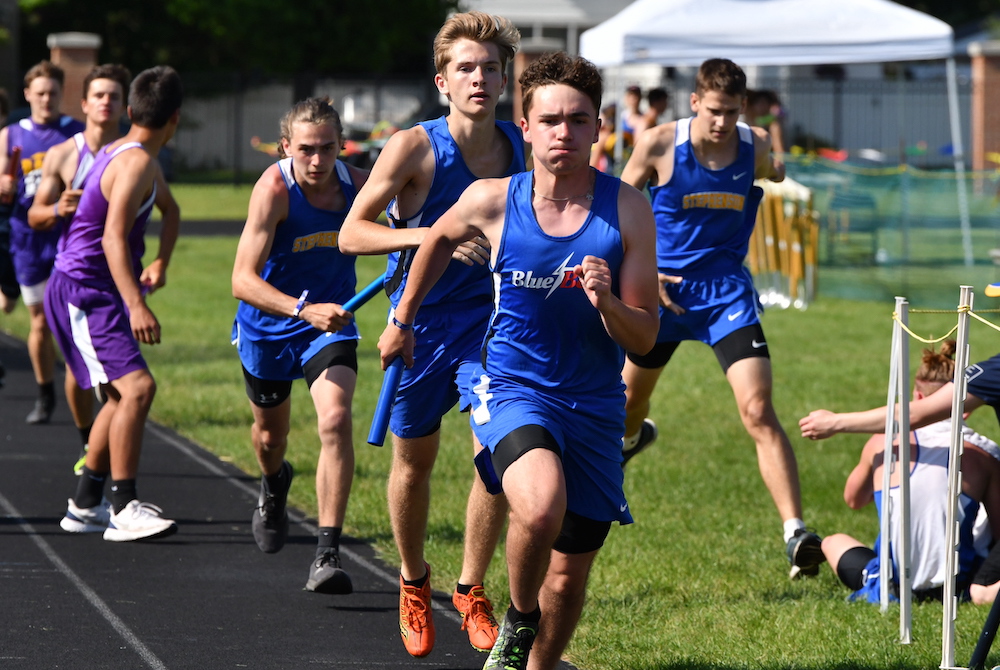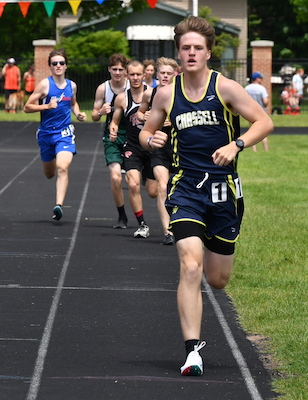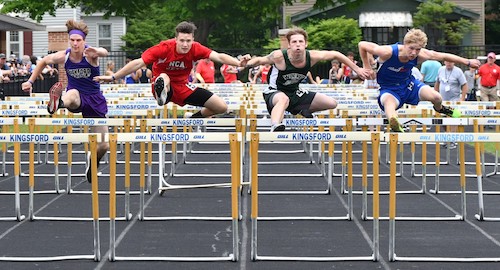
Dollar Bay Cashes In on School Records for 1st Finals Title
By
John Vrancic
Special for MHSAA.com
June 6, 2021
KINGSFORD — History was made in the Upper Peninsula Division 3 Track & Field Finals on Saturday as the Dollar Bay Blue Bolts were crowned champions for the first time with 67 points.
They were followed by Pickford with 55 and Rapid River with 47.
Dollar Bay set school records while winning the 1,600-meter relay in three minutes, 42.88 seconds and 3,200 relay in 8:31.01.
 Bessemer had won the 3,200 relay eight years in a row. The Speedboys, however, took third this time (8:58.64).
Bessemer had won the 3,200 relay eight years in a row. The Speedboys, however, took third this time (8:58.64).
“We got it done,” said senior and Bay College basketball recruit Davin Hill. “Our coach pushed us hard all year. Our practices were harder than the meets.”
Senior John Norland anchored the winning 3,200 relay and took the 400 (51.38) and 800 (2:07.1).
“We knew we had a chance to win the U.P. Finals,” he said. “I ran my second-fastest split (2:01) in the 3,200 relay. The 400 and 800 are tough races. The 800 is very close to a sprint.”
Conner LeClaire added a first in the 300 hurdles (42.33) and second in the 110s (17.63).
Pickford’s lone first came on Hayden Taylor’s toss of 42 feet, 8¼ inches in shot put with Cedarville senior Drew Bailey taking second (42-2).
Rapid River senior Parker Dausey won discus (126-1) and classmate Max Lenaker took high jump (6-1).
North Central took the 400 relay (46.32) and sophomore Luke Gorzinski captured the 200 (23.29), edging Republic-Michigamme’s Isaac Lawrence by two hundredths of a second.
Lawrence won long jump (20-2) and placed third in the 100 (11.69), one hundredth of a second behind Munising’s Micaiah Peramaki.
 Brimley senior Cameron Hoornstra won the 100 (11.62), and Rudyard’s Gannon Smith took pole vault (10-6).
Brimley senior Cameron Hoornstra won the 100 (11.62), and Rudyard’s Gannon Smith took pole vault (10-6).
Chassell senior Kolson Kytta became a double winner, taking the 1,600 in a school-record 4:35.37 and 3,200 (10:45.14) on a hot and humid day in Dickinson County.
“I did a lot of visualization about how I thought the races would do,” said Kytta, who’s considering running at Michigan Tech. “I put in a lot of training to get better. I don’t think the heat affected me too much.”
Lake Linden-Hubbell recorded its lone first in the 800 relay (1:38.04), and Carney-Nadeau senior Tim Hodson crossed first in the 110 hurdles (17.58).
“Our handoffs looked pretty good,” said senior Caleb Klein, who anchored the winning 800 relay. “This was our best time all year ,and I think the competition helped us a lot. All the adrenalin from all the fans being here also got me going.”
PHOTOS: (Top) Dollar Bay's A.J. Datto passes the baton to Davin Hill during the 1,600 relay Saturday. (Middle) Chassell's Kolson Kytta leads the pack after completing six laps of the 3,200. (Below) Carney-Nadeau's Tim Hodson won the 110 hurdles with Connor LeClaire from Dollar Bay taking second, Pickford's Josh Sullivan taking third, and Powers North Central’s Trenton Naser taking fourth. (Photos by Cara Kamps. Click to see more at RunMichigan.com.)

Track Gaining Speed Toward Future with Electronic Starting Devices
By
Steve Vedder
Special for MHSAA.com
May 23, 2023
Aubrey Greenfield thinks it might be the perfect time to reevaluate 130 years of tradition.
For a number of reasons, from technical to personal, the Oxford senior sprinter believes it makes sense for the crack of a starting pistol to be eliminated from high school track meets.
Because track meets would benefit in various ways from lowering costs to easier setup at meets to the human factor of competitors not having to flinch at the crack of a pistol shot, Greenfield believes the sport has a chance to embrace new technology – electronic starting devices (ESD).
In essence, an ESD replaces the starting pistol with a light flash, tone sound or both to begin a race.
"High school sports should put the athlete first," Greenfield said. "We should promote sports, and eliminating starting pistols promotes health in terms of PTSD or trauma for athletes and spectators and that would be good. I would like to think people would say that's a good idea."
In fact, Greenfield would go as far as to say if there was not an implementation of electronic starting devices, many of her teammates would have considered giving up the sport.
"If it's something that helps us compete safely, we're all for it," she said.
Greenfield's opinion apparently is spreading. Michigan High School Athletic Association senior assistant director Cody Inglis said the use of ESD makes it both affordable for meet starters and sensible for athletes and fans to rethink the use of starting pistols. While the MHSAA is not mandating electronic starting devices, it does promote the use of what Inglis calls "emerging technology." He notes that ESD are becoming the norm for organizations such as USA Track & Field, the NCAA and an increasing number of high schools.
 "I think we have to embrace new technology, and we think this will be something that takes hold," Inglis said.
"I think we have to embrace new technology, and we think this will be something that takes hold," Inglis said.
A key part of embracing ESD is the human element. The tragic Oxford High School shooting Nov. 30, 2021, that took the lives of four students while injuring seven others should not be relived even for a fleeting instance at a high school sporting event. Oxford athletic director Tony DeMare said the school began using ESD at every meet, including the MHSAA Lower Peninsula Division 1 Finals last June. He said that decision was embraced by virtually all schools Oxford encountered.
"We were very convinced that the alternative (of ESD) would promote a healthy attitude," DeMare said. "We were overwhelmed with the positive response. If a school was on the fence about it or might not be for it, I think we've started to see the tide turn in favor of people willing to listen and learn about electronic starting devices."
Inglis said the MHSAA is acutely aware of what the crack of a starting pistol can mean to athletes and fans.
"It's unimaginable what Oxford went through, and this is a small way we can help," he said. "We look at a (starting pistol) and think, ‘Could we do something else?’ It's a way of helping to solve a problem."
Over the last several years, the MHSAA has embraced finding an alternative to starting pistols. Inglis noted the discussion started with the cost and diminishing availability of 32-caliber ammunition that meet starters use. A box of ammunition, if it can be found, is around $75 a box.
In addition to cost, there is potential damage from excessive exposure to 150-plus decibels of sound generated by the traditional 32-caliber blanks. Medical studies show damage to ears caused by decibel levels above 120 dB.
The tragedy at Oxford accelerated the conversation.
Inglis said the cost of ESD can be likened to a school sinking money into artificial surfaces at football fields. Yes, there is a great cost at first, but over time money is ultimately saved. An ESD system itself ranges between $200 and $500. Speakers also may need to be purchased, but with ESD starting events like the 800 and 1,600-meter relays positioned near the outside lanes 8, 7, 6 and 5 would result in improved hearing by athletes at the start of a race.
There is one challenge with ESD that track administrators are working to overcome – lighting conditions that lessen the ability to see the ESD’s LED light or strobe when the button is pressed by a starter to begin a race. But that vision difficulty resulting from clear blue skies and backgrounds of setting suns can be substantially improved by incorporating a black background with an ESD – something as simple as a starter holding up black cardboard behind the lighting mechanism at the start of an event.
Inglis said when all factors are considered, the use of ESD makes sense.
 "With the climate we live in nowadays, no lookalike guns is good," he said. "We're not mandating this. But people are saying this is affordable."
"With the climate we live in nowadays, no lookalike guns is good," he said. "We're not mandating this. But people are saying this is affordable."
While switching to ESD would break 130 years of tradition, the timing could be a step forward, said Jeff Hollobaugh, co-author of the book "The Fleet Feet of Spring: Michigan's High School State Championships in Track & Field." He said while no definitive answer is possible, it's likely starting pistols were used at the inaugural state meet at the Jackson Fairgounds in 1895. The meet, which included events like tossing a 16-pound shot put, bike races and a 100-meter sprint, was sponsored by the Michigan Interscholastic Athletic Association (a predecessor to the MHSAA) and comprised mostly of the state's larger schools.
Hollobaugh's sentiments echo what many involved in today's high school track & field believe in terms of making a transition from starting pistols to electronic starting devices.
"It's a change, not necessarily good or bad, just different," he said. "It's not a drastic change, but it will take some getting used to. But it is the future. In the end, we'll all be fine."
DeMare believes the future of high school track will definitely include ESD.
"Our desire is that the practicality and sensibility of this will overcome the alternative," he said. "I think we'll see the automation and electronics taking hold of certain elements in track, and people will embrace it."
PHOTOS (Top) Runners watch official Bertha Smiley as they prepare to begin a race during last season's Lower Peninsula Division 1 Finals at Rockford. (Middle) An electronic starting device provided by VS Athletics was used to start those races. (Below) Smiley sets to begin an event. (Photos provided by David Kuderka/VS Athletics.)

